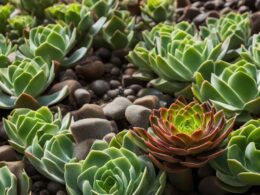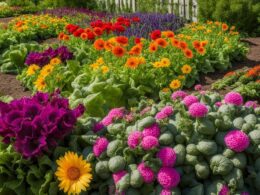Are you looking for a way to enhance your home environment while enjoying the benefits of nature? Look no further than growing moss indoors. Moss is not only a beautiful addition to your space, but it also offers numerous advantages that can improve your well-being. From improved air quality to easy maintenance, let’s explore the amazing benefits of incorporating moss into your indoor gardening.
Post Summary
- Moss improves air quality by filtering out air pollutants more efficiently than other plants.
- Indoor moss gardening requires minimal maintenance, making it an easy and hassle-free option.
- Growing moss indoors creates a calming atmosphere, promoting a sense of tranquility and well-being.
- Moss is a sustainable plant option as it requires no fertilizer and can be easily found in outdoor areas.
- Decorating your home with moss adds a unique touch to your decor, bringing nature indoors.
Why Moss is a Sustainable Indoor Plant
Moss is an eco-friendly and sustainable indoor plant option, making it an excellent choice for indoor gardening enthusiasts. Its sustainability lies in its unique characteristics and low maintenance requirements, which contribute to a greener and more environmentally-friendly approach to gardening. Here are some key reasons why moss is considered a sustainable indoor plant:
- Moss requires no fertilizer: Unlike many other plants, moss does not rely on synthetic fertilizers to thrive. It obtains nutrients directly from the air and rain, making it a self-sufficient and low-maintenance plant.
- Abundant availability: Moss can be found in various outdoor locations, such as roadsides, forests, and parks. By collecting moss from these areas, you can avoid harming natural habitats and contribute to sustainable gardening practices.
- Low water usage: Moss has a low water requirement, making it an ideal choice for water-conscious individuals. Its ability to retain moisture allows it to thrive in humid environments, reducing the need for excessive watering.
- No need for synthetic chemicals: Moss gardens generally do not require the use of synthetic chemicals, such as pesticides or herbicides, for maintenance. This reduces the environmental impact associated with the use of such substances.
By opting for moss as an indoor plant, you can create a sustainable and eco-friendly environment while enjoying the beauty and benefits that moss brings to your space. Its ability to thrive with minimal resources and care makes it an excellent choice for those seeking a more environmentally-conscious approach to indoor gardening.
How to Create an Indoor Moss Garden
Creating an indoor moss garden is a straightforward process that allows you to bring the beauty of nature into your home. Here are some tips to help you get started:
- Choose a suitable container: Select a large, transparent container or a terrarium with a lid to create an enclosed environment for your moss garden. This will help maintain the humidity levels necessary for moss growth.
- Prepare the base: Add a layer of pebbles or saturated sand at the bottom of the container. This will provide drainage and prevent water from pooling around the moss.
- Enhance the growth: Scatter pine needles or rotten bark on top of the base. These organic materials will provide nutrients and create a favorable environment for the moss to thrive.
- Spread the moss: Collect moss from outdoor areas, such as roadsides or parking lots. Shred the moss into small pieces and spread it evenly on top of the base. Insert toothpicks into the moss to hold it securely in place.
- Maintain the moss: Mist the moss with distilled or purified water regularly to keep it damp. Avoid using tap water, as it may contain chemicals that can harm the moss. Place the container away from direct sunlight but near a light source to provide sufficient indirect light for the moss to grow.
By following these steps, you can create a thriving indoor moss garden that adds a touch of natural beauty to your home.
“Creating an indoor moss garden is a simple and enjoyable way to bring a piece of the outdoors inside. The lush green color and soft texture of moss can create a calming and serene atmosphere in any room. Whether you choose to display your moss garden in a terrarium or a glass container, it will undoubtedly become a unique and eye-catching centerpiece in your home.”
Remember, moss requires a humid environment to thrive, so regular misting is essential. Additionally, be sure to keep an eye out for any signs of drying or browning, as this may indicate a lack of moisture. With proper care and maintenance, your indoor moss garden will continue to delight and inspire.
| Indoor Moss Garden Tips | Benefits |
|---|---|
| Choose a suitable container | – Creates a controlled environment for moss growth |
| Prepare the base | – Provides drainage and prevents water accumulation |
| Enhance the growth | – Supplies nutrients and creates a favorable environment |
| Spread the moss | – Adds beauty and securely holds the moss in place |
| Maintain the moss | – Regular misting keeps the moss hydrated |
Creating an indoor moss garden is a rewarding and visually appealing way to incorporate nature into your home decor. By following these moss gardening tips, you can enjoy the lush green beauty of moss while creating a tranquil atmosphere in any room. Whether you choose to display your moss garden in a terrarium or a glass container, it will undoubtedly become a unique and eye-catching centerpiece in your home.
Moss Maintenance Tips for Winter Months
During the winter months, caring for your indoor moss garden requires some specific considerations to ensure its health and vitality. By following these moss maintenance tips, you can enjoy the beauty of your moss year-round.
Consistent Moisture
Moss thrives in moist conditions, and this is especially important during the winter when indoor environments tend to be drier. Regular misting with distilled or purified water is essential to keep the moss damp but not overly waterlogged. Aim to mist the moss every few days, ensuring it receives enough moisture to sustain its growth.
Avoid Direct Sunlight
While moss requires some light for photosynthesis, it is important to keep it away from direct sunlight during the winter. Too much light exposure can dry out the moss and harm its growth. Place your moss container in a location where it will receive indirect light or near a light source such as a bright window.
Air Circulation
During the winter months, it is beneficial to periodically remove the lid of your moss container to allow for air circulation. This will help prevent the moss from becoming stagnant and improve overall air quality within the container. By providing some ventilation, you can promote the health and vitality of your moss garden.
By following these moss maintenance tips, you can ensure the health and beauty of your indoor moss garden during the winter months. Consistent moisture, avoiding direct sunlight, and providing adequate air circulation will help your moss thrive and add a touch of natural beauty to your home environment.
| Moss Maintenance Tips for Winter Months |
|---|
| Consistent Moisture |
| Mist the moss every few days with distilled or purified water to keep it damp but not waterlogged. |
| Avoid Direct Sunlight |
| Place the moss container in a location with indirect light or near a bright window to prevent drying out. |
| Air Circulation |
| Periodically remove the lid of the moss container to allow for air circulation and prevent stagnancy. |
Decorating Your Home with Moss
Moss is not only beneficial for its environmental advantages but also for its decorative appeal. Incorporating moss into your home decor can add a touch of natural beauty and create a calming atmosphere. There are various creative ways to use moss as a decorative element, allowing you to bring a piece of nature indoors.
One popular way to decorate with moss is by creating moss terrariums. These miniature landscapes can be displayed on tabletops or shelves, adding a unique and visually appealing element to your home. To create a moss terrarium, choose a glass container with a lid and layer the base with pebbles or saturated sand for drainage. Add a layer of pine needles or rotten bark to create a natural environment for the moss. Carefully arrange the shredded moss on top, using toothpicks to secure it if needed. Place the terrarium in a well-lit area away from direct sunlight, and mist it regularly to maintain the moss’s moisture.
Decorative Uses for Moss
| Decorative Ideas | Description |
|---|---|
| Moss Wall Art | Create a living wall art piece by arranging moss on a frame or canvas. This unique artwork adds texture and a touch of nature to your walls. |
| Moss Top Dressing | Add a layer of moss on top of potted plants to create a visually interesting and natural look. The moss acts as a decorative cover for the soil and helps retain moisture. |
| Moss Centerpieces | Use moss as a base for floral arrangements or as a centerpiece on its own. It adds a rustic and organic touch to any table setting or event. |
| Moss Wreaths | Create unique and eye-catching wreaths by combining moss with other natural elements like twigs, flowers, or ornaments. Hang them on doors or walls for a touch of greenery. |
In addition to terrariums, moss can also be used as a top dressing for potted plants. By adding a layer of moss on top of the soil, you can create a visually interesting and natural look. This decorative cover not only enhances the beauty of your plants but also helps retain moisture, keeping your plants healthy and hydrated.
Moss can also be incorporated into wall art pieces or wreaths, adding texture and a touch of nature to your space. Creating a living wall art piece with moss arranged on a frame or canvas can be a stunning focal point for any room. Moss wreaths, combined with other natural elements like twigs, flowers, or ornaments, can be hung on doors or walls, adding a unique and eye-catching touch of greenery.
Whether you choose to create a moss terrarium, use moss as a top dressing for plants, or incorporate it into wall art and wreaths, decorating your home with moss allows you to bring the beauty of nature indoors. The natural and organic aesthetic of moss brings a sense of tranquility and connection to the outdoors, creating a visually interesting and calming atmosphere in your home.
Moss as a Healing Plant
Moss is not only visually appealing but also has healing properties that can greatly improve your well-being. According to Healthline, having plants, including moss, in your home can enhance your mood, increase productivity, and reduce stress and fatigue. Moss has the ability to filter out pollutants from the air, contributing to improved air quality and creating a healthier indoor environment.
By bringing moss into your home, you can create a calming atmosphere that promotes relaxation and tranquility. The presence of moss can have a positive effect on your mental and emotional well-being, especially during the winter months when access to greenery and outdoor air is limited. Its organic and natural element provides a connection to nature, which has been shown to have therapeutic benefits.
“Having plants, including moss, in your home can enhance your mood, increase productivity, and reduce stress and fatigue.”
Additionally, moss has been proven to release phytoncides, a natural antimicrobial substance that has a positive impact on our immune system. Breathing in these phytoncides can boost our immune function and help us fight off illnesses. Incorporating moss into your indoor environment can provide these health benefits while adding a touch of natural beauty to your space.
Summing Up
Moss is not just a beautiful plant, but it also offers healing properties that can improve your overall well-being. By introducing moss into your home, you can enjoy its ability to enhance your mood, reduce stress, and boost your immune system. Plus, its filtering qualities contribute to better air quality, creating a healthier environment for you and your loved ones. Consider incorporating moss into your indoor space and experience the healing benefits it has to offer.
Conclusion
In conclusion, growing moss indoors offers a multitude of benefits that can greatly enhance your home environment. By bringing the beauty of nature inside, you can enjoy improved air quality, easy maintenance, and a calming atmosphere. Moss acts as a natural air filter, effectively removing pollutants and creating a healthier living space for you and your family.
Not only is moss a sustainable plant option, but it also requires minimal care and can be easily accessed. By following the simple steps of creating an indoor moss garden and implementing proper maintenance practices, you can enjoy the beauty and benefits of moss year-round. Additionally, moss can be used as an intriguing and unique decorative element, adding a touch of tranquility and connection to nature to your home decor.
Furthermore, moss has been recognized for its healing properties, improving well-being by enhancing mood, increasing productivity, and reducing stress and fatigue. Incorporating moss into your indoor space can provide a sense of tranquility and improve your mental well-being, especially during the winter months when access to greenery and fresh air may be limited.
In summary, growing moss indoors is a wonderful way to bring nature into your home and experience its amazing benefits. From improved air quality to a calming environment to its healing properties, moss offers a multitude of advantages. Consider incorporating moss into your indoor gardening and decor, and enjoy the beauty and serenity it brings to your living space.
FAQ
What are the benefits of growing moss indoors?
Growing moss indoors has numerous benefits, including improved air quality, easy maintenance, and the creation of a calming atmosphere.
Why is moss a sustainable indoor plant?
Moss is a sustainable plant option because it requires no fertilizer, can be found easily in many areas, and has low maintenance requirements.
How can I create an indoor moss garden?
To create an indoor moss garden, you will need a large, transparent container or a terrarium, pebbles or saturated sand for the base, pine needles or rotten bark to enhance moss growth, and moss collected from outdoor areas.
How do I maintain moss during the winter months?
Moss maintenance during winter involves providing consistent moisture through regular misting, keeping it away from direct sunlight, and occasionally removing the container lid to allow the moss to air out.
How can I incorporate moss into home decor?
Moss can be used to top dress plants, displayed in glass jars or terrariums, or arranged as a living wall art piece. You can also add crumpled bits of moss around the base of your moss garden to utilize every bit of collected moss.
What are the healing properties of moss?
Moss has been recognized for its ability to improve well-being by enhancing mood, increasing productivity, and reducing stress and fatigue. It also helps improve air quality by filtering out pollutants.
How Can Indoor Plant Support Ideas Benefit Moss Growth Indoors?
Indoor plant support ideas can benefit moss growth indoors by providing a structure for the moss to cling onto and thrive. Support structures like trellises, moss poles, or wall brackets can create a stable environment for the moss to grow vertically, making it easier to maintain and display indoors.













